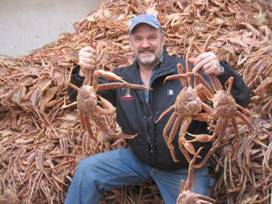If you’ve been following along here at Heligirl for any amount of time you must know by now that I’m a bit of a Deadliest Catch fan. I’ve had the extreme pleasure to chat with many of the captains and crews on the show as well as the hard-working Discovery folks who put it together.
So when I was approached by a PR company working with Wizard Captain Keith Colburn, asking if I’d be interested in talking with Keith about his campaign to increase boating safety this summer, I was thrilled for the opportunity.
Viewers of Deadliest Catch always see these salty sea dogs pounding through the rough Bering Sea and inhospitable weather with little emphasis on all the preparation they took to make these journeys. Rest assured, safety is always foremost, not just for deckhands doing the fishing, but also the operation of the boat.
Captain Keith signed on to spend a good portion of his summer with Crown Royal (yes, the whisky) to help get the word out to boaters – Safety First!
Keith was a busy boy earlier this week, calling a bunch of us writers in between radio and TV appearances as a part of the boating safety campaign. But he took a moment as he sat aboard the Wizard to call while my kids played quietly (thank God) in the backyard.
“Now that the boating season is upon us, it’s really important that people take steps to boat responsibly by starting their safety at the dock,” the seasoned captain and boater said.
Captain Keith recommends if you’ll be boating at any time, this season or any other time for that matter, regardless of whether you’re taking a small sailboat or captaining a yacht, to follow a few important safety steps:
- File a float plan by telling someone when you’re leaving, where you’re going and when to be back. If this person can’t reach you within a reasonable time from your estimated time of arrival back, he or she should notify the Coast Guard.
- Check your safety equipment before leaving. Everything should be in working order and you should have enough life vests for everyone, including child size vests for children. Adult vests are not made for children and relying on one for a child means putting your child at serious risk.
- Make sure someone heading out with you knows how to use the radio and operate the boat should something happen to you.
- Always check your weather before you leave. Weather changes fast, especially here in the Pacific Northwest. Make sure you’re well aware of all forecasts during your entire trip before leaving the dock.
- Wait until you’re safely back at the dock and everything is secure before having a drink.
“There’s plenty of time to start celebrating after everyone is safe and sound back on dry land,” Captain Keith emphasized. “Being at the helm of a boat is no different than the driver’s seat of a car. You should never be drinking while operating a water vessel. Wait until everyone is home safe.”
He’s also worked with the US Coast Guard, who posted this video: Keith talks about safe boating.
Of course, he didn’t mention the bit about making sure whoever is on watch stays awake, but I’m thinking that just might have been a bit of a sore spot given this week’s episode of Deadliest Catch.


















{ 3 comments }
Twitter: audcole
May 20, 2011 at 12:22 pm
My boss and I were both dragging this morning. I said “Did you see Deadliest Catch this week? We may need that…” and she said “Wake up alarm thing the kid turned off?! YES!!” Luckily, if we do fall asleep (it’s still very much a possibility) the worst that will happen is we’ll crack our heads on our desks, not sink a boat. So, we’ve got that going for us! 🙂
Several years ago when I was the captain of a small tanker (ok, it was a 40 ft. fueling boat), I was getting the boat going one morning, to find a sheen of gas covering most of the harbor I worked out of. Found out through the grapevine that one of the local sport fishing captains had 3 or 4 too many before going to the fuel dock, and put the fueling nozzel into a rod holder instead of the fuel line. He didn’t realize what he had done until he had pumped in way over what he had expected to take on (about 200 gal. I imagine). The fuel ended up in his engine room. Luckily for him, he was sober enough to realize that starting his engine, with a bilge full of fuel would be a really bad thing. So, he had a buddy tow his boat back to his slip, where he proceeded to pump the bilge of all this fuel, during the dark of the night.
A few fingers were pointed at me that morning. I just rolled my eyes, reminded them that I am a professional, and told them there was no way I would have been dumb enough to cover the harbor with fuel. Enough said.
Now if you’re wondering what happened to all of that fuel, there are 8-10 ft. tides in that area and lots of little microbes in the ocean that love to eat fuel. Between the tide and wave action and the bugs, it was taken care of in a few days.
Susan recently posted: Healing is Happening- An Akashic Record Healing Update
Really cool to read Captain Keith’s pointers on boat safety. Surely he would know–can’t believe they regularly go out in the conditions they show on Deadliest Catch.
#3 is a particularly good tip–most people think about making sure they have at least some safety gear, but how many of us make sure our co-boaters know how to operate the boat and gear just in case something happens? Thanks for that reminder.
Mike recently posted: Selecting a Lawyer